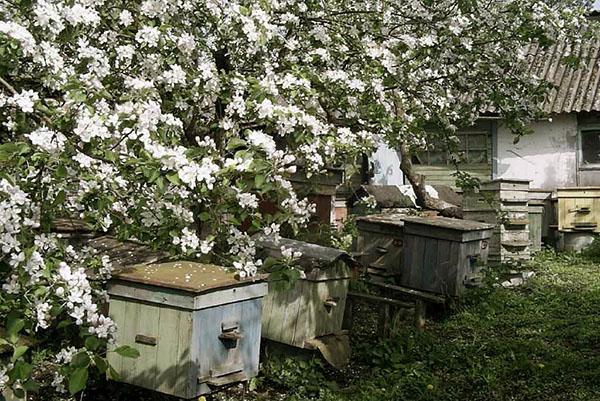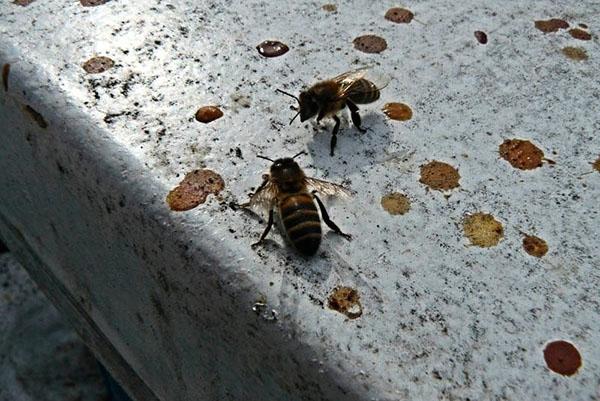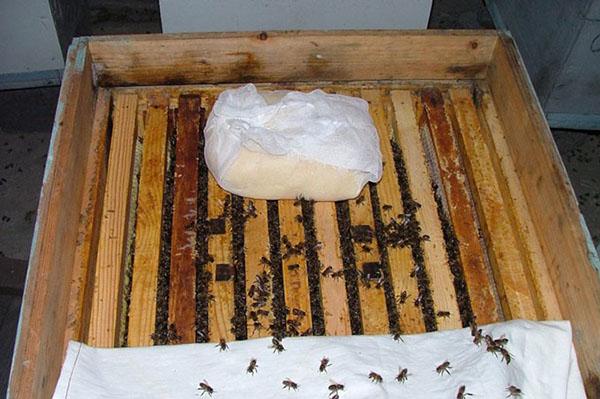Spring work in the apiary (video and description)
 Spring begins very early for beekeepers. As in the video dedicated to beekeeping, spring work in the apiary takes place from March, and in some cases from the last days of February. At the first signs of warmth, insects gradually disappear from winter torpor, and they quickly enough begin to actively work to tidy up the hive.
Spring begins very early for beekeepers. As in the video dedicated to beekeeping, spring work in the apiary takes place from March, and in some cases from the last days of February. At the first signs of warmth, insects gradually disappear from winter torpor, and they quickly enough begin to actively work to tidy up the hive.
Early spring work in the apiary and preparation for the flyby
However, for the first time, a novice beekeeper leading spring work in an apiary should not rush and interfere with the life of bee colonies. After wintering, they are quite vulnerable, they do not tolerate temperature changes, outside interference and daylight. In the room where the hives are located, use a red lantern, and actions inside the hive can be performed quickly and painlessly for the inhabitants.

A video for beginners on where to start in an apiary in the spring months will help prevent annoying mistakes and help you prepare for the new season and honey harvest.
The first thing bees do with the arrival of heat is cleaning the cells for future eggs. As a result of increased processing of bee bread and honey, the insect organism produces additional waste.
In such a situation, until the bees fly out of the hive, it is dangerous and overly active intervention, and illiterate feeding.
Top dressing and preventive work in the apiary in spring
 It is worth artificially feeding the bees in the apiary in the spring only if the insects have a deficiency of food. To do this, cakes are made from candied and dissolved in a water bath honey and powdered sugar, wrapped in several layers of clean gauze and, covered with a film, laid out over the frames. The same can be done if, during spring work in an apiary, a novice beekeeper has full combs with honey.
It is worth artificially feeding the bees in the apiary in the spring only if the insects have a deficiency of food. To do this, cakes are made from candied and dissolved in a water bath honey and powdered sugar, wrapped in several layers of clean gauze and, covered with a film, laid out over the frames. The same can be done if, during spring work in an apiary, a novice beekeeper has full combs with honey.
While all the bees are in the hives, and the main parasites and pathogens are not yet active, it is high time for recovery and prevention of common diseases. Here are just a few tips given by experts in apiary work in the spring:
- For this purpose, when symptoms of nosematosis are detected, fummagillin is introduced into the composition of a sweet cake, 2 grams per 1 kg of feeding.
- The sugar syrup used for dressing is flavored with dill oil at the rate of 3 grams per liter. This measure helps to prevent the spread of varroatosis.
- For the same purpose, a filtered infusion of a liter of water, 10 grams of dry eucalyptus leaves with 1 kg of sugar is used, which is safe for insects.
- As a means to increase immunity, 30–40 grams of decoction of pine or spruce needles per liter of syrup are added to the feed.
 A video about spring work in an apiary will suggest other useful techniques that will be of interest to both beginners and experienced beekeepers.
A video about spring work in an apiary will suggest other useful techniques that will be of interest to both beginners and experienced beekeepers.
Arrangement of an apiary in spring
Before the exhibition of bees, it is important to carry out all the work on the arrangement of the apiary, including:
- cleaning the territory from last year's garbage;
- preparation of places for installing hives, it is better that these are the same sites as last year;
- installing drinkers and filling them with clean water with a little salt addition.
When it comes time to move the hives out of the winter house, it is necessary to wait for stable warm weather, when the air is warmed up to 12-15 ° С. It is better for a beginner beekeeper to carry out this spring work in an apiary on a calm, windless day, otherwise it will be difficult to keep track of the departing bees.
The removal of the hives is carried out very carefully, avoiding jerks, roll or impacts. When all the houses are arranged, there is no need to rush and open a large number of hives at once. First, the most "noisy" families are released, then one by one they open the entrances at 1–2 hives in each row. The following families are released at intervals of several minutes.
 Anyone who is engaged in beekeeping, a video about spring work in an apiary will help to quickly navigate and enter the new honey season without losses.
Anyone who is engaged in beekeeping, a video about spring work in an apiary will help to quickly navigate and enter the new honey season without losses.
Cleaning flight and family audit
Upon departure, an experienced beekeeper easily receives information about the condition of the bees. The more active the insects, the better they overwintered, and at the moment they are freed from the excrement accumulated during the winter.
 Weak bees cannot climb high enough, and sometimes they completely remain on the walls or the entrance. This situation is most often observed in several cases:
Weak bees cannot climb high enough, and sometimes they completely remain on the walls or the entrance. This situation is most often observed in several cases:
- over the winter, the family was left without a queen, and now the insects are in a kind of confusion;
- there was little food in the hive and the insects weakened during the winter;
- the population of the hive is sick with nosematosis or has been attacked by ticks.
If during the first flyby the beekeeper identifies such problem families, checking the condition of all nests and cleaning them must be included in the spring work schedule in the apiary.
 All kinds of debris accumulated during the autumn and winter months, as well as all honeycombs with signs of mold, are subject to removal. To prevent the death from causing the spread of infection, it is buried or burned. The beekeeper replaces the defective frames with spare ones, with honey, thereby taking care of the members of weakened families. Do not forget about checking and restoring the deteriorated thermal insulation over the winter.
All kinds of debris accumulated during the autumn and winter months, as well as all honeycombs with signs of mold, are subject to removal. To prevent the death from causing the spread of infection, it is buried or burned. The beekeeper replaces the defective frames with spare ones, with honey, thereby taking care of the members of weakened families. Do not forget about checking and restoring the deteriorated thermal insulation over the winter.
Since there is already brood in the hives by this time, all work in the apiary in May and other spring months is carried out very quickly and carefully so as not to chill out the hive. Families that have lost their uterus need to be replenished by introducing a uterus in a cell from a nucleus into the hive.
 For novice beekeepers and everyone who is interested in beekeeping and spring work in an apiary, a video on this topic will allow you to better understand the sequence of operations and visually present all the nuances of each stage.
For novice beekeepers and everyone who is interested in beekeeping and spring work in an apiary, a video on this topic will allow you to better understand the sequence of operations and visually present all the nuances of each stage.
Cleaning and revision of hives in the spring in the apiary
It is most convenient to deal with hives, the bottoms of which can be easily removed. In this case, the bottom of the structure is carefully passed with any tool that allows you to remove all the build-ups formed during the winter. Then the surface is washed with hot water or doused with boiling water and dried. The blowtorch gives the greatest disinfecting effect.
If at the disposal of a novice beekeeper who conducts spring work in an apiary, whole hives, then here you cannot do without spare houses, where the frames are rearranged. After cleaning and revising the hive space, all contents are returned to their original place.
Frames with honey and bee bread, located along the edges of the combs with brood, must be opened and sprinkled with warm water. For food, bee colonies are allocated 3-4 frames with honey and one less frame with bee bread. If there is no such amount of feed in the spring, food is carried out at the expense of syrup or sweet cakes based on honey and powdered sugar.
 Spring quickly recaptures the domain of winter, and every day the beekeeper has more and more important troubles and worries. Work in the apiary in May consists in the formation of layering of bee colonies and preparation for the first bribe in the new season.
Spring quickly recaptures the domain of winter, and every day the beekeeper has more and more important troubles and worries. Work in the apiary in May consists in the formation of layering of bee colonies and preparation for the first bribe in the new season.
Since about a month after the first emergence, almost the entire overwintered generation of worker bees dies out, it is replaced by young individuals of this year.So that the hives do not bleed out, and the egg production of the uterus is at a high level, until fresh spring nectar appears, do not forget about feeding. When the brood occupies most of the frames, except for the most extreme ones, additional combs are placed with a small amount of honey on top, the cells with which are opened when placed in the hive. If the beekeeper does not have ready-made frames with honey, you can use empty ones, having previously treated them with syrup.
The onset of stable warm weather indicates the need to expand the entrances and remove pillows. If this is not done in time, the danger of swarming and the loss of a family increases sharply. And with the blooming of the first melliferous plants, spring work in the apiary passes into the stage of preparation and receiving the first bribe.